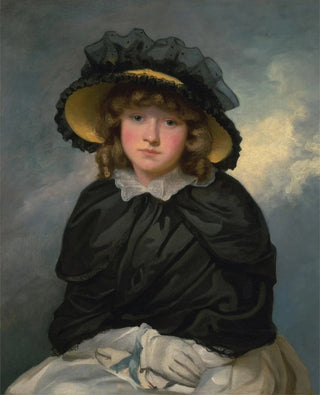Art print | Cécilia - John Hoppner


View from behind

Frame (optional)
In the world of 18th-century English painting, the art print "Cécilia" by John Hoppner stands out for its timeless beauty and undeniable charm. This delicate depiction of a young woman, imbued with grace and gentleness, evokes an atmosphere of serenity and elegance. Hoppner, renowned for his mastery of portraits, manages to capture not only the physical appearance of his subject but also an emotional essence that transcends mere visual representation. Through this work, the viewer is invited to delve into the intimate universe of Cécilia, an invitation to explore the nuances of her character and the subtleties of her inner world.
Style and uniqueness of the work
John Hoppner's style is characterized by a blend of realism and romanticism, where light plays a fundamental role in creating a poetic atmosphere. In "Cécilia," soft tones and delicate color nuances harmonize to bring the central figure to life. The meticulous details of the face, clothing, and hair demonstrate the attention paid to a faithful representation of the model. Hoppner employs glazing techniques that add depth and texture, allowing each brushstroke to tell a story. Cécilia's posture, both natural and posed, reinforces this impression of spontaneity and vitality, making this work a true masterpiece of classical portraiture.
The artist and his influence
John Hoppner, born in 1758, is often regarded as one of the greatest portraitists of his time, rivaling artists such as Sir Joshua Reynolds. Trained at the Royal Academy, he developed a personal style that allowed him to stand out in the London art scene. His influence extends beyond his contemporaries, as he captured the spirit of his era while anticipating future developments in portrait painting. Hoppner successfully combined realism with a certain idealization, creating works that speak to both the heart and the mind. His impact is still felt today, as many contemporary artists draw inspiration from his ability to convey emotions through painting.

Matte finish

View from behind

Frame (optional)
In the world of 18th-century English painting, the art print "Cécilia" by John Hoppner stands out for its timeless beauty and undeniable charm. This delicate depiction of a young woman, imbued with grace and gentleness, evokes an atmosphere of serenity and elegance. Hoppner, renowned for his mastery of portraits, manages to capture not only the physical appearance of his subject but also an emotional essence that transcends mere visual representation. Through this work, the viewer is invited to delve into the intimate universe of Cécilia, an invitation to explore the nuances of her character and the subtleties of her inner world.
Style and uniqueness of the work
John Hoppner's style is characterized by a blend of realism and romanticism, where light plays a fundamental role in creating a poetic atmosphere. In "Cécilia," soft tones and delicate color nuances harmonize to bring the central figure to life. The meticulous details of the face, clothing, and hair demonstrate the attention paid to a faithful representation of the model. Hoppner employs glazing techniques that add depth and texture, allowing each brushstroke to tell a story. Cécilia's posture, both natural and posed, reinforces this impression of spontaneity and vitality, making this work a true masterpiece of classical portraiture.
The artist and his influence
John Hoppner, born in 1758, is often regarded as one of the greatest portraitists of his time, rivaling artists such as Sir Joshua Reynolds. Trained at the Royal Academy, he developed a personal style that allowed him to stand out in the London art scene. His influence extends beyond his contemporaries, as he captured the spirit of his era while anticipating future developments in portrait painting. Hoppner successfully combined realism with a certain idealization, creating works that speak to both the heart and the mind. His impact is still felt today, as many contemporary artists draw inspiration from his ability to convey emotions through painting.






